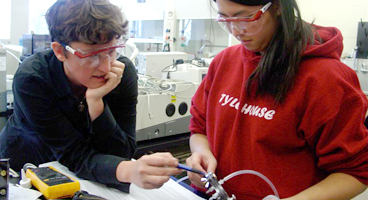Document Type
Article
Publication Date
9-2016
Publication Title
Ear and Hearing
Abstract
Objective: The objective is to develop methods to utilize newborn reflectance measures for the identification of middle-ear transient conditions (e.g., middle-ear fluid) during the newborn period and ultimately during the first few months of life. Transient middle-ear conditions are a suspected source of failure to pass a newborn hearing screening. The ability to identify a conductive loss during the screening procedure could enable the referred ear to be either (1) cleared of a middle-ear condition and recommended for more extensive hearing assessment as soon as possible, or (2) suspected of a transient middle-ear condition, and if desired, be rescreened before more extensive hearing assessment.
Design: Reflectance measurements are reported from full-term, healthy, newborn babies in which one ear referred and one ear passed an initial auditory brainstem response newborn hearing screening and a subsequent distortion product otoacoustic emission screening on the same day. These same subjects returned for a detailed follow-up evaluation at age 1 month (range 14 to 35 days). In total, measurements were made on 30 subjects who had a unilateral refer near birth (during their first 2 days of life) and bilateral normal hearing at follow-up (about 1 month old). Three specific comparisons were made: (1) Association of ear’s state with power reflectance near birth (referred versus passed ear), (2) Changes in power reflectance of normal ears between newborn and 1 month old (maturation effects), and (3) Association of ear’s newborn state (referred versus passed) with ear’s power reflectance at 1 month. In addition to these measurements, a set of preliminary data selection criteria were developed to ensure that analyzed data were not corrupted by acoustic leaks and other measurement problems.
Results: Within 2 days of birth, the power reflectance measured in newborn ears with transient middle-ear conditions (referred newborn hearing screening and passed hearing assessment at age 1 month) was significantly greater than power reflectance on newborn ears that passed the newborn hearing screening across all frequencies (500 to 6000 Hz). Changes in power reflectance in normal ears from newborn to 1 month appear in approximately the 2000 to 5000 Hz range but are not present at other frequencies. The power reflectance at age 1 month does not depend significantly on the ear’s state near birth (refer or pass hearing screening) for frequencies above 700 Hz; there might be small differences at lower frequencies.
Conclusions: Power reflectance measurements are significantly different for ears that pass newborn hearing screening and ears that refer with middle-ear transient conditions. At age 1 month, about 90% of ears that referred at birth passed an auditory brainstem response hearing evaluation; within these ears the power reflectance at 1 month did not differ between the ear that initially referred at birth and the ear that passed the hearing screening at birth for frequencies above 700 Hz. This study also proposes a preliminary set of criteria for determining when reflectance measures on young babies are corrupted by acoustic leaks, probes against the ear canal, or other measurement problems. Specifically proposed are “data selection criteria” that depend on the power reflectance, impedance magnitude, and impedance angle. Additional data collected in the future are needed to improve and test these proposed criteria.
Keywords
middle ear; reflectance, newborn hearing screening, otitis media, immittance
Volume
37
Issue
5
First Page
560
Last Page
571
DOI
10.1097/AUD.0000000000000293
Creative Commons License

This work is licensed under a Creative Commons Attribution 4.0 International License.
Rights
Licensed to Smith College and distributed CC-BY under the Smith College Faculty Open Access Policy.
Version
Author's Accepted Manuscript
Recommended Citation
Voss, Susan E.; Herrmann, Barbara S.; Horton, Nicholas J.; Amadei, Elizabeth A.; and Sharon, Kujawa G., "Reflectance Measures from Infant Ears With Normal Hearing and Transient Conductive Hearing Loss" (2016). Engineering: Faculty Publications, Smith College, Northampton, MA.
https://scholarworks.smith.edu/egr_facpubs/142


